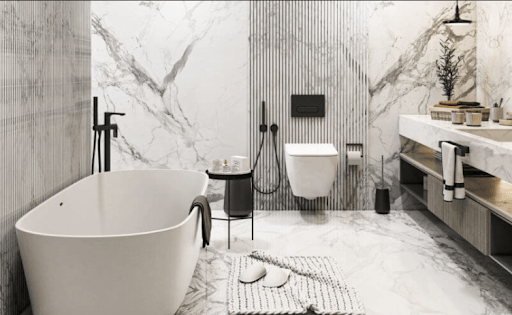Interior designing is a multifaceted process that involves conceptualising, planning, and executing design solutions to enhance the functionality, aesthetics, and comfort of interior spaces. While some individuals may perceive hiring an interior designer as an unnecessary expense, the reality is quite the opposite. In fact, engaging the services of a professional interior designer can prove to be a wise investment that not only saves you time and money but also ensures the successful realisation of your design vision. In this blog post, we explore the various ways in which hiring an interior designer can lead to cost savings and efficiency gains for your project.
Expertise in Space Planning and Layout Optimization:

One of the primary advantages of hiring an interior designer is their expertise in space planning and layout optimization. Designers possess the knowledge and skills to assess the spatial requirements, traffic flow, and functional needs of a space, and to develop efficient and ergonomic layouts accordingly. By maximising space utilisation and minimising wasted areas, designers help optimise the use of available square footage, ultimately saving you both time and money in the long run.
Access to Industry Resources and Discounts:
Interior designers have access to a vast network of industry contacts, including suppliers, vendors, and contractors. As a result, they can leverage their relationships to secure competitive pricing on materials, furnishings, and other design elements. Additionally, many designers receive trade discounts from their suppliers, which they can pass on to their clients. By tapping into these resources and discounts, designers can help you save significantly on the cost of materials and services, ultimately reducing the overall project expenses.
Avoidance of Costly Mistakes and Rework:

Inexperienced individuals attempting to design their own spaces may inadvertently make costly mistakes that result in wasted time and resources. From selecting incompatible materials to overlooking critical design considerations, the potential for error is high. Interior designers, on the other hand, bring a wealth of knowledge and experience to the table, enabling them to anticipate and avoid common pitfalls. By guiding you through the design process and providing expert advice, designers help minimise the risk of costly mistakes and the need for expensive rework down the line.
Efficient Project Management and Coordination:
Managing an interior design project involves coordinating multiple stakeholders, including contractors, vendors, and suppliers. Without proper oversight, the project can easily veer off track, leading to delays, budget overruns, and frustration. Interior designers serve as project managers, overseeing every aspect of the project from start to finish. They handle procurement, scheduling, and coordination, ensuring that the project stays on schedule and within budget. By entrusting the project management responsibilities to a professional designer, you can save valuable time and resources while ensuring a seamless and efficient project execution.
Value Engineering and Cost Optimization:

Interior designers are skilled in value engineering, a process that involves identifying opportunities to reduce costs without sacrificing quality or performance. By analysing the project scope, materials, and design elements, designers can identify cost-saving alternatives and efficiencies that help optimise the project budget. Whether it’s specifying cost-effective materials or proposing alternative design solutions, designers work to maximise the value of every dollar spent, ultimately saving you money without compromising on the design integrity or functionality of the space.
Streamlined Decision-Making Process:
The decision-making process can be overwhelming for individuals undertaking an interior design project on their own. From choosing paint colours and finishes to selecting furniture and accessories, the myriad choices can lead to decision paralysis and indecision. Interior designers streamline the decision-making process by providing expert guidance and recommendations based on your preferences, budget, and project goals. By presenting curated options and facilitating informed choices, designers help you make decisions more efficiently, saving you time and minimising the risk of costly changes or revisions later on.
Optimization of Resources and Assets:
Interior designers excel at optimising resources and assets to achieve maximum value and impact. Whether it’s repurposing existing furniture, reconfiguring layout configurations, or integrating multifunctional design solutions, designers find creative ways to make the most of your available resources. By maximising the utility and longevity of your assets, designers help you avoid unnecessary expenditures on new purchases or replacements, ultimately saving you money and reducing waste.
Mitigation of Scope Creep and Change Orders:
Scope creep, or the gradual expansion of project scope beyond its original boundaries, can lead to increased project costs and delays. Interior designers help mitigate scope creep by establishing clear project objectives, defining deliverables, and setting realistic timelines and budgets from the outset. By maintaining strict adherence to the project scope and minimizing changes mid-project, designers help prevent costly change orders and ensure efficient project progress.
Expedited Access to Design Solutions:
Interior designers possess a wealth of knowledge and experience in sourcing materials, furnishings, and design elements. Their familiarity with reputable suppliers, manufacturers, and vendors enables them to expedite the procurement process and access design solutions efficiently. By leveraging their industry connections and expertise, designers help you avoid lengthy lead times and delays associated with sourcing materials independently, ultimately saving you valuable time and expediting project timelines.
Reduction of Stress and Decision Fatigue:
Interior design projects can be inherently stressful, particularly for individuals without prior experience in design or construction. The sheer number of decisions to be made, coupled with the pressure to meet deadlines and budgets, can lead to decision fatigue and overwhelm. Interior designers alleviate stress and decision fatigue by assuming responsibility for the design process, managing project logistics, and providing guidance and support every step of the way. By serving as a trusted advisor and advocate, designers help you navigate the complexities of the design process with confidence and peace of mind.
Enhanced Return on Investment (ROI):
Investing in professional interior design yields a higher return on investment (ROI) by enhancing the value, appeal, and marketability of your property. Interior designers possess the expertise to identify strategic design opportunities that maximize property value and appeal to prospective buyers or tenants. By investing in design elements that enhance curb appeal, functionality, and aesthetics, designers help increase the perceived and tangible value of your property, ultimately yielding a higher ROI when it comes time to sell or lease.
Long-Term Cost Savings through Sustainable Design:
Sustainable design practices not only contribute to environmental conservation but also result in long-term cost savings for property owners. Interior designers specialise in integrating sustainable design principles and features that reduce energy consumption, water usage, and maintenance requirements over the lifespan of a property. By specifying energy-efficient appliances, sustainable materials, and passive design strategies, designers help lower utility bills, minimise operational costs, and prolong the longevity of building systems and components. These long-term cost savings offset the initial investment in sustainable design, resulting in a net reduction in lifecycle costs for property owners.
Conclusion:
In conclusion, hiring an interior designer can yield significant time and cost savings for your interior design project. From expertise in space planning and layout optimization to access to industry resources and discounts, designers offer valuable insights and efficiencies that help streamline the design process and minimize expenses. By avoiding costly mistakes, efficient project management, and value engineering, designers ensure that your project stays on track, within budget, and meets your design goals and expectations. As such, investing in the services of a professional interior designer is not just an expense but a strategic investment that can ultimately save you both time and money while achieving the desired outcomes for your space.






